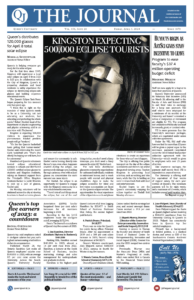Habiba Esaad wants to rewrite history.
In her fourth year of the Fine Arts program at Queen’s, Esaad is looking inwards to her experience as a queer person of colour for inspiration to inform her critique of art history.
For Esaad, the focus of her thesis project has been to look to art history as a means of critiquing. Through painting, print, performance, and digital works, she’s using history to inform the future.
The project is a new direction for Esaad, who’s never focused on herself in her previous work. Feminist and queer academic works inspired the change.
“It was almost like, ‘Well, if people are writing about it, and I’m experiencing it, why can’t I make art about it?’” Esaad told The Journal in an interview.
While the self isn’t the focal point in much of her work, her perspective and experience is injected in every piece. Her media work is largely focused on her figure, and in many of her paintings she uses her body as a paintbrush.
Some of Esaad’s more recent art has been based on the work of Yves Klein, who painted with blue paint using women’s bodies.
“He would basically invite women to his studio and call them living brushes and paint them all in blue from the neck down and give them a set of instructions on how they would press their bodies against canvasses or roll around the floor,” she said.
In her representations of Klein’s work, Esaad covered her face in blue paint and pressed it into rice paper. She calls it “Putting Faces to Klein’s Bodies” as recognition of the role of the bodies used in the creation of Klein’s paintings.
“[Klein] never once cited any of the women as contributors and their faces were never included in the works,” Esaad explained.
Unlike the Klein paintings, some of Esaad’s works are inspired more from her perspective than her physical being.
Her painting “Disjecta Membra” is based on Rembrandt’s famous painting “Anatomy Lesson.”
“There was one body or cadaver being dissected by various white men who are just standing around in their fluffed up collars in some sort of passive amusement,” Esaad said.
Her painting emulates the scene but gives less emphasis to the figures in the background. They have no definition, while the body in the foreground has much more movement.
In the painting, she’s taking focus away from the powerful and giving a voice to the subject that’s overlooked in the painting. In this way, Esaad views her work as utopian.
She sees a world in which she can live in her own body and her own experience without judgement.
By rewriting history, Esaad is creating a future for herself in which being a queer person of colour doesn’t require justification.
Tags
Kingston Art, Queen's Art, student art, Student Artist Profile
All final editorial decisions are made by the Editor(s)-in-Chief and/or the Managing Editor. Authors should not be contacted, targeted, or harassed under any circumstances. If you have any grievances with this article, please direct your comments to journal_editors@ams.queensu.ca.

